Closely behind in second place is France, followed by Germany. Spain is the biggest riser. London’s M25 region is Europe’s most expensive for distribution rents. Central and Eastern Europe, already the focus of considerable interest, is the main area for future expansion, given next year’s eastward expansion of the European Union.
The best country in Europe to locate a distribution centre is Belgium, according to European Distribution, a report by Cushman & Wakefield Healey & Baker (C&W/H&B), which operates the European division of global real estate consultant Cushman & Wakefield.
Belgium retains its No. 1 position, scoring particularly well for its competitively priced accommodation close to the geographical heart of the European Union, and the country’s excellent transportation systems.
France moves up two places in the ranking to 2nd, scoring well from its excellent road freight system, low site costs and transportation links. Germany retains 3rd position, with its ranking boosted by efficient air and rail freight systems. The biggest riser is Spain, which goes up three places to 12th, scoring well for its improved transportation.
The ranking takes into account 15 factors considered important to operators deciding on where to locate a distribution centre. The European Distribution report also compares rents for prime distribution units of 10,000 sq m units in 42 locations across Europe: the M25, London’s outer ring road, has the highest rental levels in Europe, in particular the Heathrow area, followed by Stockholm and Moscow.
Western European countries have taken the top slots for ’best countries to locate a distribution centre’, but the focus of future expansion and interest lies east in the search for new markets and cheaper production centres. The Czech Republic is currently the highest positioned country from this region taking 5th place in the ranking.
Next year’s eastward expansion of the EU will bring an additional 75 million consumers to create the world’s biggest trading block in terms of numbers of people. As the EU’s centre of gravity shifts eastwards, it will only be a matter of time before the logistics sector follows, the report says.
“Europe’s current distribution arteries are centred on the well-established hubs of Western Europe. Traditionally they have formed a boomerang from Birmingham in the UK to the north, Barcelona and Madrid to the south and Germany to the east,” says John Greenwood, C&W/H&B’s Head of European Industrial.
“EU expansion is stretching the boomerang eastwards to give it a more crescent shape. Looking forward, new trade routes will develop and additional hubs will emerge to facilitate efficient distribution.”
Across Europe, but in particular in Central and Eastern European locations, demand is being driven by retailers and the auto sector seeking out Europe’s new emerging markets, with third party logistics operators setting up pan-European distribution networks.
In the ranking, peripheral countries tend to have lower scores, reflecting their remote access and distance to market, but two important hubs stand out:
- The port of Barcelona - a port of entry for sea freight coming from Asia and the new link to the high-speed train, TGV system in France.
- Helsinki, which provides transport routes to and from Russia, Europe’s largest emerging market, with a population of 143 million.
Source: C&W H&B







